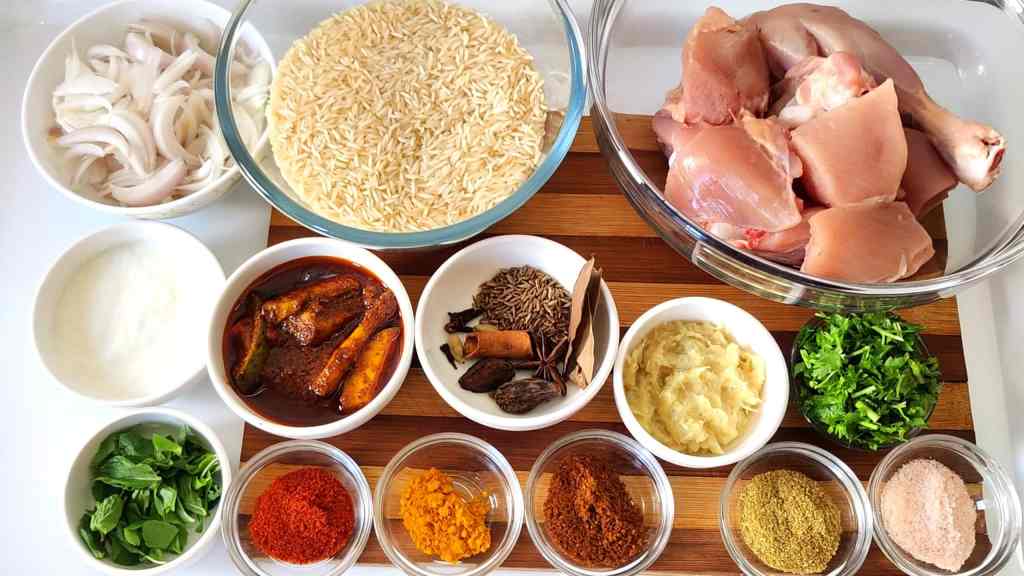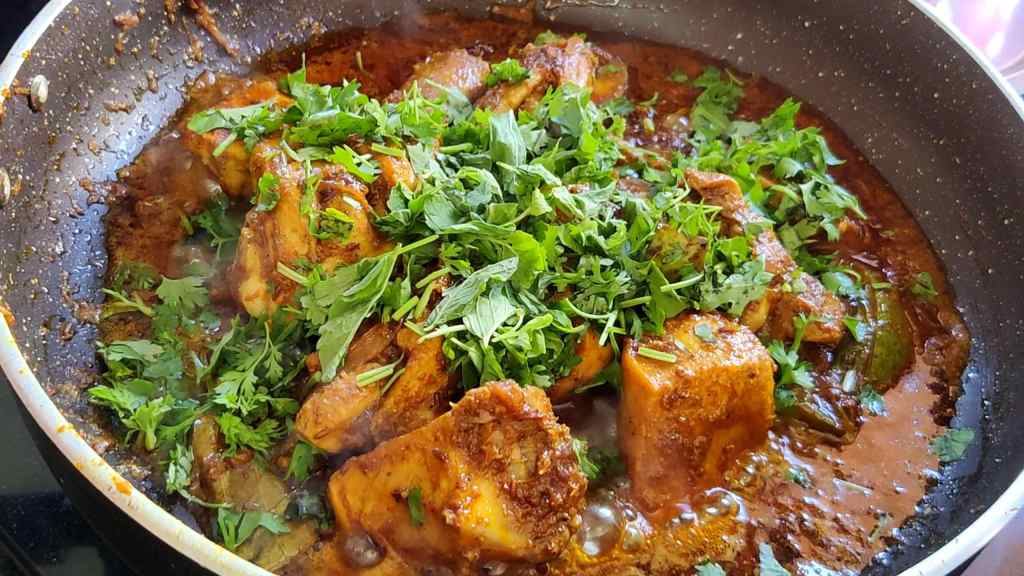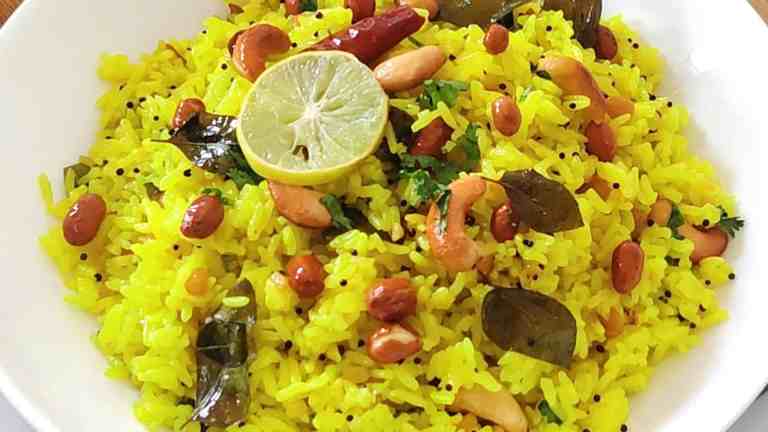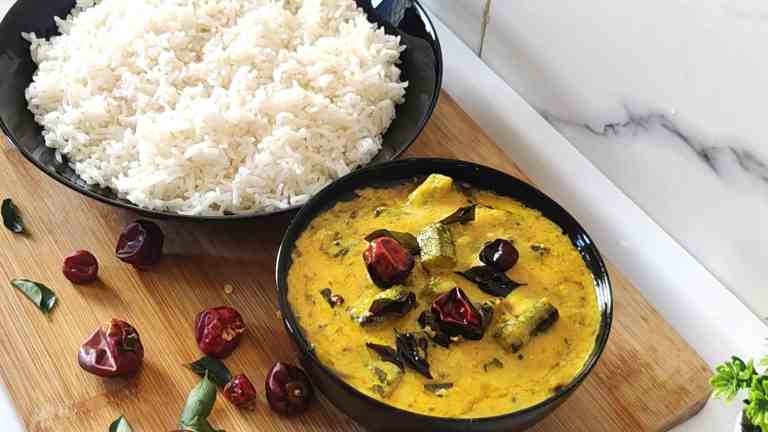Avakaya Biryani Recipe (Mango Pickle Biryani)
Avakaya Biryani is a delicious and flavorful biryani that is popular in the Indian state of Andhra Pradesh. It is made with mango pickle, also known as avakaya, which is a traditional pickle recipe from Andhra Pradesh made with raw mangoes and spices. The pickle adds a tangy and spicy flavor to the biryani, making it a complete meal that is perfect for any occasion. You can use either regular avakaya (other pickled fruits) or mango avakaya for this recipe, depending on your preference. It is a great recipe to try during mango season, and it is certain to be a hit with all South Indians or Indian food aficionados who love the flavorful biryani and the aromatic spices of Andhra style cooking.

The flavor of avakaya biryani is a combination of the spicy and tangy flavors of the mango pickle, the aromatic spices used in the biryani, and the flavors of the other ingredients, such as rice, chicken, or vegetables. The biryani typically uses long grain basmati rice, which is a type of aromatic rice that has a nutty and fragrant flavor. This biryani has aromatic flavors and spices, such as garam masala, red chili powder, and mustard seed powder. This gives it a distinctive and flavorful taste.
You can make avakaya biryani during mango season, when unripe mangoes are readily available, or anytime with mango pickle that you bought or preserved yourself. It is a popular dish in Andhra Pradesh and people of all ages enjoy it. Yes, kids love this dish!
You can serve it as a main course at special occasions and celebrations, such as weddings and festivals. You can serve it with raita or yogurt on the side, or with other accompaniments like salan or mirchi ka salan.
History of Avakaya Biryani
The history of avakaya biryani is as old as the history of avakaya pickle itself. Avakaya pickle is a popular condiment in Andhra Pradesh. It is centuries old, with records dating back to the ancient Hindu epic, the Mahabharata. Unripe mangoes are pickled in a mixture of mustard powder, sesame oil, and other spices to make Avakaya pickle. Traditionally, it is made in large quantities during mango season and stored in glass bottles for use throughout the year.
Avakaya Biryani evolved as a way to use up leftover avakaya pickle, by mixing it with rice and other ingredients to create a flavorful and complete meal. You can make it with a variety of meats or vegetables, and serve it as a main course at special occasions and celebrations.
Dum Method For Avakaya Biryani
You can make avakaya biryani using the dum method or on the stove top. The dum method, also known as the “dum pukht” or “dum biryani” method, is a traditional Indian method of cooking rice and meat (or vegetables) together in a sealed pot or pan over low heat. This method allows the flavors to meld together and the dish to become more flavorful. You can make it with chicken or vegetables for a vegetarian version.
Ingredients For Avakaya Biryani

Rice
The main ingredient in avakaya biryani is rice. Long grain basmati rice varieties are ideal for this biryani. This type of rice is aromatic and has a nutty and fragrant flavor, which enhances the overall flavor of the biryani. It also has a fluffy and light texture, which helps to balance out the spicy and tangy flavors of the mango pickle and other ingredients.
Mango Pickle (avakaya)
Mango pickle, or avakaya, is a traditional pickle recipe from Andhra Pradesh which consists of raw mangoes and spices. It adds a tangy and spicy flavor to the biryani, as well as a slightly sour taste due to the presence of vinegar or lemon juice in the pickle. It also adds a unique texture to the biryani, with the chunks of mango in the pickle providing a slight crunch.
Meats or Vegetables
You can make avakaya biryani with a variety of meats or vegetables, such as chicken, lamb, shrimp, or mushrooms. The meat or vegetables add flavor and protein to the biryani, and they also contribute to the overall texture of the dish.
Spices
Avakaya biryani is flavored with a variety of aromatic spices, such as red chili powder, mustard seed powder, garam masala, and star anise. These spices add flavor and depth to the biryani, as well as a warm and aromatic aroma.
Herbs
Avakaya biryani is often garnished with herbs, such as coriander leaves and mint leaves, which add a fresh and aromatic flavor to the biryani.
Garlic
Garlic is often used in avakaya biryani to add flavor and depth to the dish. It has a strong and pungent flavor that complements the spicy and tangy flavors of the mango pickle and other ingredients.
Cooking Instructions For Avakaya Biryani
Rinse the rice several times until the water runs clear. Then, soak the rice in water for 30 minutes.

In a separate bowl, marinate the chicken with yogurt and powdered spices like red chili, coriander, garam masala, salt, and turmeric.

Marinate the chicken for about 30 minutes to absorb all the spices and yogurt.

In a large pot or pan, heat the oil or ghee over medium heat. Add the whole spices, like bay leaf, cumin seeds, star anise, cardamom, and cinnamon, and sauté until fragrant.

Then add the chopped onions and green chilies and sauté them for another two or three minutes.

When the onions turn a nice golden brown color, add garlic and ginger paste and sauté them together.

Now add the marinated chicken to the onion and garlic mix and fry the chicken in the mixture.

Then cover and cook the chicken for about ten minutes, until it is almost eighty percent cooked.

Next, add the avakaya mango pickle to the pot. You can also add slices of raw mango along with the pickles for additional flavor.

Mix it well to allow the flavors to meld together.

Add coriander and mint to the mixture and mix them well.

Add about 3 cups of water to the chicken. Cover and simmer on medium for 10 minutes.

Then add the soaked rice to the chicken mixture and mix it together.

Cook on medium-high heat for 10 minutes with lid on.

Stir once more, then cover and cook the biryani on low heat for an additional 10 minutes, or until the rice is cooked, and the water has been absorbed.

In the end, fluff the biryani with a spoon or fork and serve hot as a main course, accompanied by raita or yogurt if desired.

Serving Suggestions

Serve it with raita or yogurt
Raita or yogurt is a refreshing and cooling side dish that pairs well with the spicy and tangy flavors of avakaya biryani. You can serve raita or yogurt on the side, or mix it into the biryani for a creamier texture.
Accompany it with salan or mirchi ka salan
Salan is a spicy and flavorful sauce that is commonly served with biryani in Andhra Pradesh. Mirchi ka salan is a variant of salan made with chili peppers, and it is also a popular accompaniment to biryani. These sauces add a spicy and tangy flavor to the biryani and help to balance out the flavors of the dish.
Serve it with papad or poppadoms
Papad or poppadoms are thin and crispy Indian snacks that are often served with biryani. They add a crunchy texture to the biryani and provide a contrast to the softer texture of the rice and other ingredients.
Accompany it with a side of pickle
Avakaya biryani is made with mango pickle, so serving it with a side of pickle can add an extra layer of flavor to the dish. You can serve any type of pickle that you like, such as lemon pickle or mixed vegetable pickle.
Garnish it with fresh herbs
Garnishing avakaya biryani with fresh herbs, such as coriander leaves or mint leaves, adds a fresh and aromatic flavor to the dish.
Storing Suggestions
Keep it covered and refrigerated
To store avakaya biryani, it is best to keep it covered and refrigerated. This will help to prevent the biryani from drying out and maintain its freshness. You can use a tight-fitting lid or plastic wrap to cover the biryani before refrigerating it.
Reheat it carefully
When reheating avakaya biryani, it is important to do so carefully to prevent it from becoming dry or overcooked. You can either microwave the biryani in short bursts, or reheat it on the stove top over low heat, adding a little water or broth to keep it moist.
Freeze it for longer storage
If you want to store avakaya biryani for a longer period of time, you can freeze it. To freeze the biryani, transfer it to an airtight container or a freezer-safe bag and seal it tightly. When ready to eat, thaw the biryani in the refrigerator and reheat it as desired.
Avoid storing it at room temperature
It is not recommended to store avakaya biryani at room temperature for an extended period of time, as it can become spoil and lose its flavor and texture.

Hi! I’m Ravi Kumar.
I am a husband, father of 4, board certified neurosurgeon, and a lover of South Indian Food!
I created PaattisKitchen.com to memorialize the most delicious foods on earth. South Indian food is easy to make and hard to mess up. So pull up your sleeves, and come with me as we explore the vibrant spices, colors, aromas, and flavors of South Indian culinary tradition.







